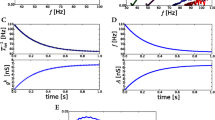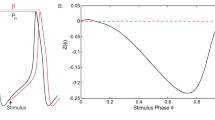Abstract
We describe four different mechanisms that lead to oscillations in a network of two reciprocally inhibitory cells. In two cases (intrinsic release and intrinsic escape) the frequency of the network oscillation is insensitive to the threshold voltage of the synaptic potentials. In the other two cases (synaptic release and synaptic escape) the network frequency is strongly determined by the threshold voltage of the synaptic connections. The distinction between the different mechanisms blurs as the function describing synaptic activation becomes less steep and as the model neurons are removed from the relaxation regime. These mechanisms provide insight into the parameters that control network frequency in motor systems that depend on reciprocal inhibition.
Similar content being viewed by others
References
Arshavsky YI, Orlovsky GN, Panchin YV, Roberts A, Soffe SR (1993) Neuronal control of swimming locomotion: analysis of the pteropod molluscClione and embryos of the amphibianXenopus. TINS 16:227–233.
Arbas EA, Calabrese RL (1987) Slow oscillations of membrane potential in interneurons that control heartbeat in the medicinal leech. J. Neurosci. 7:3953–3960.
Bonet C (1987) Singular perturbation of relaxed periodic orbits. J. Diff. Eqns. 66:301–339.
Brown TG (1911) The intrinsic factors in the act of progression in the mammal. Proc. Roy. Soc. Lond. B84:308–319.
Calabrese RL, DeSchutter E (1992) Motor-pattern-generating networks in invertebrates: modeling our way toward understanding. TINS 15:439–445.
Cohen AH, Rossignol S, Grillner S, eds (1988) Neural Control of Rhythmic Movements in Vertebrates. John Wiley and Sons Inc. New York.
Delcomyn F (1980) Neural basis of rhythmic behaviour in animals. Science 210:492–498.
DeSchutter E, Angstadt JD, Calabrese RL (1993) A model of graded synaptic transmission for use in dynamic network simulations. J. Neurophysiol. 69:1225–1235.
Gear CW (1971) Numerical Initial Value Problems in Ordinary Differential Equations. Prentice-Hall Inc, Englewood Cliffs, New Jersey.
Getting PA (1989a) Emerging principles governing the operation of neural networks. Ann. Rev. Neurosci. 12:185–204.
Getting PA (1989b) A network oscillator underlying swimming inTritonia. In: Jacklet JW, ed. Neuronal and Cellular Oscillators. Marcel Dekker Inc., New York.
Harris-Warrick RM, Marder E (1991) Modulation of neural networks for behavior. Ann. Rev. Neurosci. 14:39–57.
Jacklet JW, ed (1989) Neuronal and Cellular Oscillators. Marcel Dekker Inc., New York.
Kopell N, Somers, D (1993) Anti-phase solutions in relaxation oscillators coupled through excitatory interactions. (submitted).
Llinás RR (1988) The intrinsic electrophysiological properties of mammalian neurons: Insights into central nervous system function. Science 242:1654–1664.
LoFaro T, Kopell N, Marder E, Hooper SL (1994) Subharmonic coordination in networks of neurons with slow conductances. Neural Comp. 6:69–84.
Marder E (1993) Modulating membrane properties: role in information processing. In: Poggio TA, Glaser DA, eds., Exploring Brain Functions: Models in Neuroscience. John Wiley and Sons Ltd. pp. 27–42.
Mishchenkov EF, Rosov N (1980) Differential Equations with Small Parameters and Relaxation Oscillations. Plenum Press, New York.
Morris C, Lecar H (1981) Voltage oscillations in the barnacle giant muscle fiber. Biophys. J. 35:193–213.
Perkel DH, Mulloney B (1974) Motor pattern production in reciprocally inhibitory neurons exhibiting postinhibitory rebound. Science 185:181–183.
Rowat PF, Selverston AI (1993) Modelling the gastric mill central pattern generator of the lobster with a relaxation-oscillator network. J. Neurophysiol. 70:1030–1053.
Satterlie RA (1985) Reciprocal inhibition and postinhibitory rebound produce reverbation in a locomotor pattern generator. Science 229:402–404.
Selverston AI, Moulins M (1985) Oscillatory neural networks. Ann. Rev. Physiol. 47:29–48.
Selverston AI, Moulins M eds (1987) The Crustacean Stomatogastric System. Berlin: Springer-Verlag.
Sharp AA, O'Neil MB, Abbott LF, Marder E (1993) Dynamic clamp: Computer-generated conductances in real neurons. J. Neurophysiol. 69:992–995.
Skinner FK, Gramoll S, Calabrese RL, Kopell N, Marder E (1994) Frequency control in biological half-center oscillators. In: Eeckman F, Bower JM, eds., Computation and Neural Systems. Kluwer Academic Publishers, Boston (In press).
Skinner FK, Turrigiano GG, Marder E (1993) Frequency and burst duration in oscillating neurons and two cell networks. Biol. Cyber. 69:375–383.
Somers D, Kopell N (1993) Rapid synchronization through fast threshold modulation. Biol. Cyber. 68:393–407.
Wang X-J, Rinzel J (1992) Alternating and synchronous rhythms in reciprocally inhibitory model neurons. Neural Comp. 4:84–97.
Author information
Authors and Affiliations
Corresponding author
Rights and permissions
About this article
Cite this article
Skinner, F.K., Kopell, N. & Marder, E. Mechanisms for oscillation and frequency control in reciprocally inhibitory model neural networks. J Comput Neurosci 1, 69–87 (1994). https://doi.org/10.1007/BF00962719
Received:
Revised:
Accepted:
Issue Date:
DOI: https://doi.org/10.1007/BF00962719




